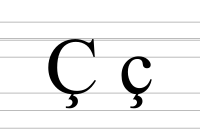C# Check Type With Is Without Casting Again
| Ç | |
|---|---|
| Ç ç | |
| (See below) | |
 | |
| Usage | |
| Writing system | Latin script |
| Blazon | Alphabetic and Logographic |
| Language of origin | Old Castilian linguistic communication |
| Phonetic usage | [s] [t͡ʃ] [d͡ʒ] [t͡s] [d͡z] [ç] [ɽ] [ǂ] [θ] [ð] |
| Unicode codepoint | U+00C7, U+00E7 |
| History | |
| Development |
|
| Fourth dimension period | ~900 to nowadays |
| Descendants | None |
| Sisters | None |
| Transliteration equivalents | ch, c, south, ts |
| Variations | (Come across below) |
| Other | |
| Other letters usually used with | c, ch, s, ts |
Ç or ç (C-cedilla) is a Latin script letter, used in the Albanian, Azeri, Manx, Tatar, Turkish, Turkmen, Kurdish, Zazaki, and Romance alphabets. Romance languages that use this letter include Catalan, French, Friulian, Ligurian, Occitan, and Portuguese as a variant of the alphabetic character C with a cedilla. Information technology is also occasionally used in Crimean Tatar and in Tajik (when written in the Latin script) to represent the /d͡ʒ/ sound. Information technology is often retained in the spelling of loanwords from any of these languages in English, Basque, Dutch, Castilian and other Latin script spelled languages.
It was offset used for the sound of the voiceless alveolar affricate /t͡s/ in Old Castilian and stems from the Visigothic form of the alphabetic character z (Ꝣ). The phoneme originated in Vulgar Latin from the palatalization of the plosives /t/ and /chiliad/ in some conditions. Later, /t͡s/ inverse into /s/ in many Romance languages and dialects. Spanish has not used the symbol since an orthographic reform in the 18th century (which replaced ç with the now-devoiced z), but it was adopted for writing other languages.
In the International Phonetic Alphabet, /ç/ represents the voiceless palatal fricative.
Usage as a letter variant in diverse languages [edit]

Evolution from Visigoth Z to modern Ç.
In many languages, ⟨ç⟩ represents the "soft" sound /due south/ where a ⟨c⟩ would normally correspond the "hard" sound /one thousand/. These include:
- Catalan. Known as ce trencada ('broken C') in this language, where information technology tin can be used before ⟨a⟩, ⟨o⟩, ⟨u⟩ or at the cease of a discussion. Some examples of words with ⟨ç⟩ are amenaça ('menace'), torçat ('twisted'), xoriço ('chorizo'), forçut ('stiff'), dolç ('sweet') and caça ('hunting'). A well-known give-and-take with this character is Barça, a common Catalan clipping of Futbol Club Barcelona.
- French (cé cédille): français ('French'), garçon ('boy'), façade ('frontage'), grinçant ('squeaking'), leçon ('lesson'), reçu ('received' [past participle]). French does not use the character at the end of a discussion but it can occur at the beginning of a word (e.one thousand., ça, 'that').[i] It is never used in French where C would denote /s/.
- Occitan (ce cedilha): torçut ('twisted'), çò ('this'), ça que la ('nevertheless'), braç ('arm'), brèç ('cradle'), voraç ('voracious'). It can occur at the get-go of a give-and-take.
- Portuguese (cê-cedilha, cê de cedilha or cê cedilhado): information technology is used earlier ⟨a⟩, ⟨o⟩, ⟨u⟩: taça ('loving cup'), braço ('arm'), açúcar ('sugar'). Modern Portuguese does non use the grapheme at the get-go or at the finish of a word (the nickname for Conceição is São, non Ção). Co-ordinate to a Portuguese grammar written in 1550, the letter ç had the sound of /dz/ around that time. Some other grammar written around 1700 would say that the alphabetic character ç sounds like /due south/, which shows a phonetic development that is still valid today.
- Old Castilian used ç to represent /t͡s/ before /a/, /o/, /u/. It also represented /d͡z/ allophonically when it occurred before a voiced consonant.
- Early Modern Spanish used the letter ç to represent either /θ/ or /due south/ before /a/, /o/, and /u/ in much the same manner as Modern Spanish uses the letter z. Middle Spanish Spanish pronounced ç every bit /θ/, or equally /ð/ before a voiced consonant. Andalusian, Canarian, and Latin American Spanish pronounced ç as /s/, or as /z/ earlier a voiced consonant. A spelling reform in the 18th century eliminated ç from Castilian orthography.
In other languages, it represents the voiceless postalveolar affricate /t͡ʃ/ (like ⟨ch⟩ in English chalk):
- Friulian (c cun cedilie) before ⟨a⟩, ⟨o⟩, ⟨u⟩ or at the end of a word.
- Turkish and Azerbaijani alphabets: çelik ('steel') and çamur ('mud').
In Manx, information technology is used in the digraph ⟨çh⟩, which also represents /t͡ʃ/, to differentiate information technology from normal ⟨ch⟩, which represents /x/.
In loanwords only [edit]
- In Basque, ⟨ç⟩ (known equally ze hautsia) is used in the loanword curaçao.
- In Dutch, it can be found in some words from French and Portuguese, such as façade, reçu, Provençaals and Curaçao.
- In English, ⟨ç⟩ is used in loanwords such as façade and limaçon (although the cedilla mark is often dropped: ⟨facade⟩, ⟨limacon⟩).
- In modernistic Spanish it tin can announced in loanwords, especially in Catalan proper nouns.
Usage equally a divide letter in various languages [edit]
It represents the voiceless postalveolar affricate /t͡ʃ/ in the following languages:
- the 4th letter of the Albanian alphabet.
- the 4th alphabetic character of the Azerbaijani alphabet.
- the 5th letter of the Tatar alphabet (based on Zamanälif).
- the 4th letter of the Turkish alphabet.
- the tertiary letter of the Turkmen alphabet.
- the fourth letter of the Kurmanji alphabet (likewise known equally Northern Kurdish).
- the 4th letter of the Zazaki alphabet.
In the 2022 version of the Latin Kazakh Alphabet, the alphabetic character represents the voiceless alveolo-palatal affricate /tɕ/, which is similar to /t͡ʃ/.
It previously represented a voiceless palatal click /ǂ/ in Juǀʼhoansi and Naro, though the former has replaced it with ⟨ǂ⟩ and the latter with ⟨tc⟩.
The similarly shaped letter the (Ҫ ҫ) is used in the Cyrillic alphabets of Bashkir and Chuvash to stand for /θ/ and /ɕ/, respectively.
Information technology besides represents the retroflex flap /ɽ/ in the Rohingya Latin alphabet.
Janalif uses this letter to correspond the voiced postalveolar affricate /d͡ʒ/
Old Malay uses ç to represent /dʒ/ and /ɲ/.
Computer [edit]
| Preview | Ç | ç | Ꝣ | ꝣ | ||||
|---|---|---|---|---|---|---|---|---|
| Unicode name | LATIN Capital letter Alphabetic character C WITH CEDILLA | LATIN Small Letter C WITH CEDILLA | LATIN Majuscule LETTER VISIGOTHIC Z | LATIN SMALL Alphabetic character VISIGOTHIC Z | ||||
| Encodings | decimal | hex | dec | hex | december | hex | december | hex |
| Unicode | 199 | U+00C7 | 231 | U+00E7 | 42850 | U+A762 | 42851 | U+A763 |
| UTF-8 | 195 135 | C3 87 | 195 167 | C3 A7 | 234 157 162 | EA 9D A2 | 234 157 163 | EA 9D A3 |
| Numeric character reference | Ç | Ç | ç | ç | Ꝣ | Ꝣ | ꝣ | ꝣ |
| Named graphic symbol reference | Ç | ç | ||||||
Input [edit]
On Albanian, Belgian, French, Portuguese, Spanish, Turkish and Italian keyboards, Ç is directly available as a separate cardinal; however, on nearly other keyboards, including the Us and British keyboard, a combination of keys must be used:
- In the US-International keyboard layout, these are ' followed by either C or ⇧ Shift+C. Alternatively one may printing AltGr+, or AltGr+⇧ Shift+,.
- In classic Mac Bone and macOS, these are ⌥ Opt+C and ⌥ Opt+⇧ Shift+C for lower- and upper-case letter, respectively.
- In the X Window System and many Unix consoles, ane presses sequentially Compose, , and either C or ⇧ Shift+C. Alternatively, one may press AltGr+= and and so either C or ⇧ Shift+C.
- In Microsoft Windows, these are Alt+0 ii three 1 or Alt+1 3 v for lowercase and Alt+0 1 ix nine or Alt+one 2 eight for uppercase.
- In Microsoft Give-and-take, these are Ctrl+, and and then either C or ⇧ Shift+C.
- The HTML graphic symbol entity references are
çandÇfor lower- and majuscule, respectively. - In TeX and LaTeX,
\cis used for adding the cedilla accent to a letter, so\c{c}produces "ç".
Encounter likewise [edit]
- Ҹ
References [edit]
- ^ The Académie Française online lexicon also gives çà and çûdra.
| | Look up Ç or ç in Wiktionary, the complimentary dictionary. |
mitchellwhady1951.blogspot.com
Source: https://en.wikipedia.org/wiki/%C3%87
0 Response to "C# Check Type With Is Without Casting Again"
Postar um comentário